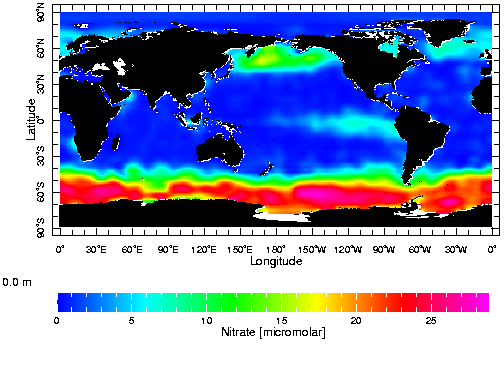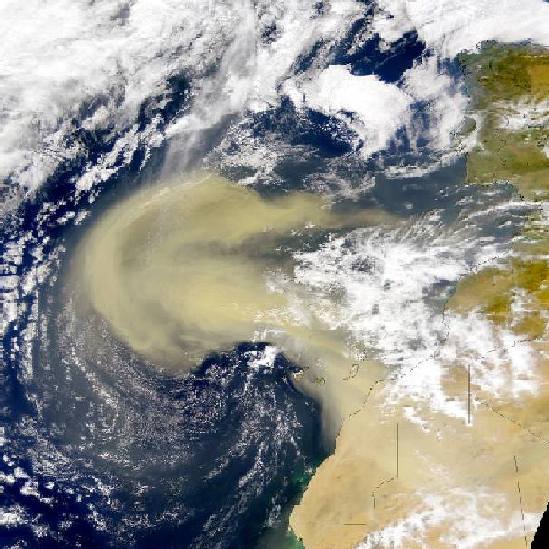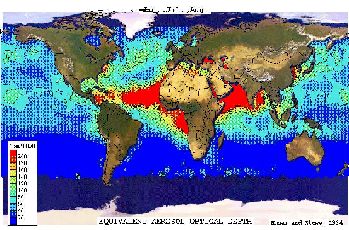 > English > Climate Encyclopaedia > Oceans > more > 2. Oceanic nutrients > - Iron in the oceans
> English > Climate Encyclopaedia > Oceans > more > 2. Oceanic nutrients > - Iron in the oceans
|
The OceansRead more |
Iron in the oceansIron is the fourth most abundant chemical element in the Earth's crust, making up around 4% of the total mass. It is an essential micronutrient for all living species. The most important source of iron to the oceans is dust and this comes almost entirely from the desert areas of the Earth. There are large regions of the oceans where there are plenty of nitrogen and phosphorous containing nutrients but not many phytoplankton. These areas are far away from the deserts and it is assumed that lack of iron prevents phytoplankton growing here.
|
Where does the iron in the oceans come from? |
Dust inputs to the oceansLarge dust particles rapidly settle out of the atmosphere but particles with a diameter of less than 10 Ám (thats 0.00001 m) can travel great distances. Winds rapidly carry the particles hight in to the air, up to 5 km over the Atlantic and 8 km over the Pacific. It takes about one week for African dust from the Sahara to cross the Atlantic Ocean and two weeks for dust to travel from the Chinese deserts to the Central Pacific Ocean. The dust particles then either fall out of the air as dry particles or are scavenged by water drops and enter the oceans in rain. |
|
|
Even though iron is very abundant in dust and lots of dust enters the oceans, iron concentrations are extremely low in seawater (generally less than 1 nmol L-1, thats <0.000000001 mol L-1!). We now know that the iron in dust occurs mainly as oxidised iron(III) complexes which are not very soluble in water. As dust is transported through clouds it encounters very acidic conditions which increase the solubility of the iron a bit. However, we still think that less than 2% of the iron entering seawater from the atmosphere is soluble and can be taken up by phytoplankton and used as a nutrient.
|
High Nitrate, Low Chlorophyll (HNLC) regions of the oceansThe major nutrients which control phytoplankton growth in the oceans are nitrate and phosphate and, to a lesser extent, silicate. In most oceans, phytoplankton grow until they have used up all of the nitrate or all of the phosphate, which ever runs out first. The subarctic Pacific, the equatorial Pacific and the Southern Ocean, however, all have plenty of these nutrients all year round but have low phytoplankton growth and corresponding low levels of chlorophyll, the photosynthetic pigment in plants. These regions are known as the HNLC regions of the oceans and make up about 20% of the total area of the ocean.
|
 |
|
3. Map of annual average nitrate concentrations in the surface waters of the oceans. This image clearly shows the high levels of nitrate in the subarctic Pacific, the equatorial Pacific and the Southern Ocean. Data from the Levitus World Ocean Atlas 1994.The scientist John Martin first suggested that it was a lack of iron in these HNLC ocean areas which prevented phytoplankton growing and scientific experiments conducted at sea confirmed this. Oceanographically these HNLC regions are all sites where the ocean circulation brings large amounts of deep water to the surface in a process known as upwelling. These deep waters contain high concentrations of the major nutrients and the waters should, in theory, be very biologically active. However, these regions are all far from the large deserts so not much dust (and therefore iron) enters the surface waters. Similar upwelling is seen north of 40 oN in the North Atlantic, but this ocean area isn't a HNLC region as it has large inputs of iron from Saharan dust.
About this page:author: Dr. Lucinda Spokes - Environmental Sciences, University of East Anglia, Norwich - U.K.
|


